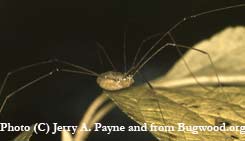|
 |
Strange Creatures on the Forest Floor
Daddy longlegs, also called harvestmen, are fascinating and misunderstood creatures. They are very close relatives to spiders, scorpions, ticks, and mites, and are within the same Arachnida Class. Because of this, daddy longlegs are often mistaken for spiders. So, how can you tell the difference? Well, if you are willing to take a closer look, you'll find that spiders have two body segments, a head and a fat abdomen, and daddy longlegs have only one rounded body segment. Spiders usually have about 8 eyes, but daddy longlegs have just 2. Also, daddy longlegs typically eat dead and decaying plant and animal matter unlike most spiders. The 8 long legs that this creature gets is name from are sometimes 30 times the size of their bodies. Daddy longlegs are very particular about these appendages and spend a great deal of time cleaning them. If this tiny creature loses a leg, the leg will continue to twitch for some time, possibly distracting predators while the daddy longlegs escapes.
Did you know?
Myth alert! Have you ever heard that the daddy longlegs is the most venomous creature on earth, but its mouth is just too small to harm us? Not true. In fact, a daddy longlegs has no fangs or venom to speak of. They have no need for either, because most of what they eat is already dead.
Learn more: Wisconsin Natural Resources
|
